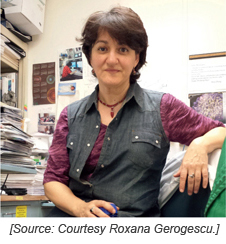Chapter Introduction
3: Chemical Basis of Information Molecules
MOMENT OF DISCOVERY

Roxana Georgescu
I was always interested to see a crystal structure of DNA going through the circular beta processivity clamp (a ring-shaped protein that associates with DNA during replication). But it was thought that beta only slides on DNA and doesn’t stick to it, so no one tried to make a DNA-beta cocrystal. However, my studies suggested that beta might stick to DNA, and I just knew it would bind DNA in an interesting fashion. The problem was, how could I make a protein crystal that I was sure contained DNA, without solving the whole structure by x-ray crystallography? I decided to use a colored DNA that should give a colored beta crystal only if DNA is in the crystal. I ordered an oligonucleotide with a fluorescent blue dye, hybridized it to another DNA strand to make a duplex, and then mixed it with beta and waited for protein crystals to form. When I took the tray out a few days later, I was shocked to see the experiment actually worked—some crystals were brilliant blue! That was one of my “Aha” moments, and I had goose bumps, because I knew I had crystals of beta protein with DNA in them. Then I realized that all I had to do next was to solve this structure. Just one problem—I didn’t know how to do x-ray crystallography.
I called Dr. Xiang-Peng Kong at NYU, who first solved the structure of this protein a decade earlier. He was more than willing to teach me, and he was such a delight to work with. But victory was not certain, because even though we knew DNA was present in the crystals, it would be completely invisible if it bound to the beta clamp protein in more than one unique way. When we collected sufficient data and the first electron density maps came into focus on the computer, we were spellbound—the electron density of helical DNA was right there in the middle of the protein, and it had a completely unexpected sharp tilt that would make the clamp spin while sliding. We would publish this for everyone to see. But for that moment, we were the only ones on Earth who knew this wonderful secret of nature, and that is a very special feeling.
—Roxana Georgescu, on her discovery of how beta processivity clamps bind DNA
Molecular biology involves the study of molecules that store and process genetic information. The chemical properties of these molecules and the principles that govern their behavior are central to understanding the maintenance and transfer of that information. Key to the storage and use of genetically encoded information are nucleic acids and proteins, macromolecules that are major constituents of all cells. These high-molecular-weight polymers are assembled from relatively simple precursors and can form three-dimensional structures that mediate a wide variety of biological activities.
The functions of nucleic acids and proteins stem from their chemical properties. Shape, electrical charge distribution, propensity to form weak or strong chemical bonds, and preference for hydrophobic (water-fearing, or water-excluding) or hydrophilic (water-loving, or water-including) interactions—all of these contribute to the ability of DNA to function as the primary repository of genetic information and the ability of proteins to enhance biochemical reaction rates. Proteins also play important structural roles in cells, and they enable cells to communicate and respond to their environment. RNA, a chemical cousin of DNA, shares the information-bearing properties of DNA and also has some structural and functional similarities to proteins. As we shall see throughout this book, new biological activities and functions for RNA are still being discovered. RNA is an important and, until recently, underappreciated controller of gene expression in all cells.
The flow of biological information in cells and organisms makes sense only in the context of the underlying chemical behavior of these biomolecules. Molecular biologists often say that a protein “recognizes” a fragment of DNA, or that an RNA molecule “binds” to a protein, or that several proteins “assemble” into a multisubunit complex, but what do these phrases really mean? A more quantitative framework for understanding cellular function requires a familiarity with the chemical principles by which molecules fold, react, and interact.
In this chapter we discuss these chemical principles, many of which developed from concepts originally drawn from the study of small molecules. We begin with the chemical building blocks of nucleic acids and proteins and a discussion of the kinds of chemical bonds that hold them together. We then discuss constraints on the behavior of biomolecules stemming from their stereochemistry, their ionization properties within the cellular environment, and their propensities to react and interact with other large and small molecules. Understanding the chemistry that governs protein and nucleic acid function provides a strong foundation for exploring the many facets of biological behavior described throughout this book.
